Intel's Pentium M Desktop Part II: ASUS' Pentium M to Pentium 4 Socket Adapter
by Anand Lal Shimpi on March 24, 2005 1:31 PM EST- Posted in
- CPUs
Workstation Applications
Visual Studio 6
Carried over from our previous CPU reviews, we continue to use Visual Studio 6 for a quick compile test. We are still using the Quake 3 source code as our test and measure compile time in seconds.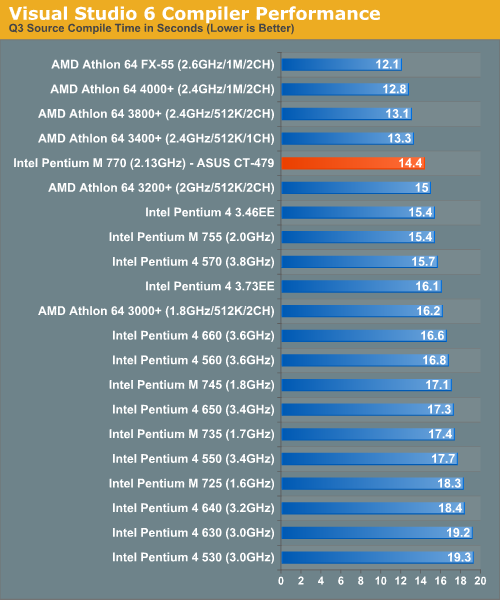
SPECviewperf 8
For our next set of professional application benchmarks, we turn to SPECviewperf 8. SPECviewperf is a collection of application traces taken from some of the most popular professional applications, and compiled together in a single set of benchmarks used to estimate performance in the various applications that the benchmark is used to model. With version 8, SPEC has significantly improved the quality of the benchmark, making it even more of a real world indicator of performance.We have included SPEC's official description of each one of the 8 tests in the suite.
The Pentium M doesn't excel in any of the SPECviewperf tests, but its performance is much more respectable with the ASUS solution, thanks to a more balanced memory bandwidth system.
3dsmax Viewset (3dsmax-03)
"The 3dsmax-03 viewset was created from traces of the graphics workload generated by 3ds max 3.1. To ensure a common comparison point, the OpenGL plug-in driver from Discreet was used during tracing.
The models for this viewset came from the SPECapc 3ds max 3.1 benchmark. Each model was measured with two different lighting models to reflect a range of potential 3ds max users. The high-complexity model uses five to seven positional lights as defined by the SPECapc benchmark and reflects how a high-end user would work with 3ds max. The medium-complexity lighting models use two positional lights, a more common lighting environment.
The viewset is based on a trace of the running application and includes all the state changes found during normal 3ds max operation. Immediate-mode OpenGL calls are used to transfer data to the graphics subsystem."
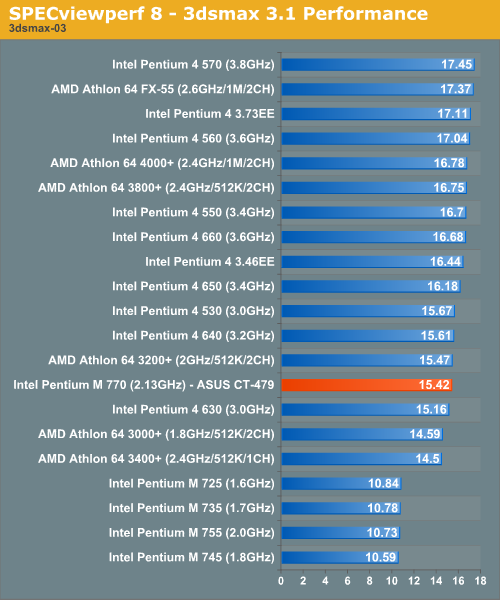
CATIA Viewset (catia-01)
"The catia-01 viewset was created from traces of the graphics workload generated by the CATIATM V5R12 application from Dassault Systems.
Three models are measured using various modes in CATIA. Phil Harris of LionHeart Solutions, developer of CATBench2003, supplied SPEC/GPC with the models used to measure the CATIA application. The models are courtesy of CATBench2003 and CATIA Community.
The car model contains more than two million points. SPECviewperf replicates the geometry represented by the smaller engine block and submarine models to increase complexity and decrease frame rates. After replication, these models contain 1.2 million vertices (engine block) and 1.8 million vertices (submarine).
State changes as made by the application are included throughout the rendering of the model, including matrix, material, light and line-stipple changes. All state changes are derived from a trace of the running application. The state changes put considerably more stress on graphics subsystems than the simple geometry dumps found in older SPECviewperf viewsets.
Mirroring the application, draw arrays are used for some tests and immediate mode used for others."
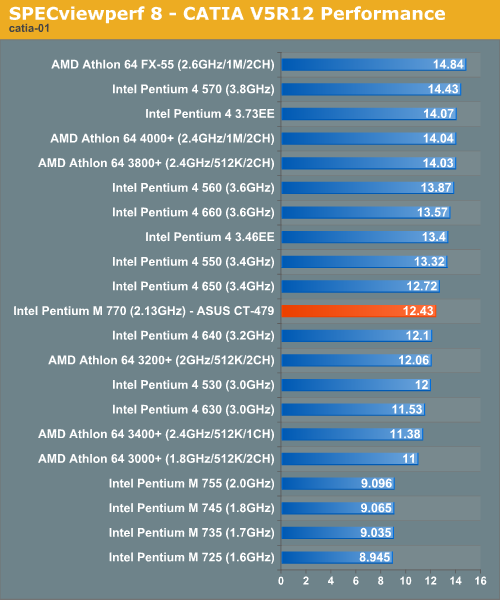
Lightscape Viewset (light-07)
"The light-07 viewset was created from traces of the graphics workload generated by the Lightscape Visualization System from Discreet Logic. Lightscape combines proprietary radiosity algorithms with a physically based lighting interface.
The most significant feature of Lightscape is its ability to simulate global illumination effects accurately by precalculating the diffuse energy distribution in an environment and storing the lighting distribution as part of the 3D model. The resulting lighting "mesh" can then be rapidly displayed."
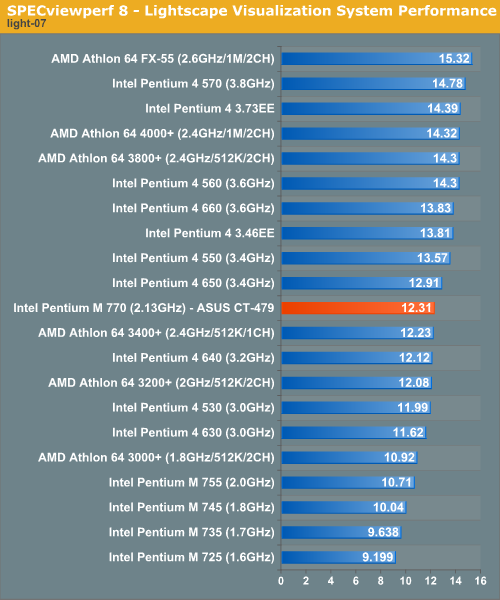
Maya Viewset (maya-01)
"The maya-01 viewset was created from traces of the graphics workload generated by the Maya V5 application from Alias.
The models used in the tests were contributed by artists at NVIDIA. Various modes in the Maya application are measured.
State changes as made by the application are included throughout the rendering of the model, including matrix, material, light and line-stipple changes. All state changes are derived from a trace of the running application. The state changes put considerably more stress on graphics subsystems than the simple geometry dumps found in older viewsets.
As in the Maya V5 application, array element is used to transfer data through the OpenGL API."
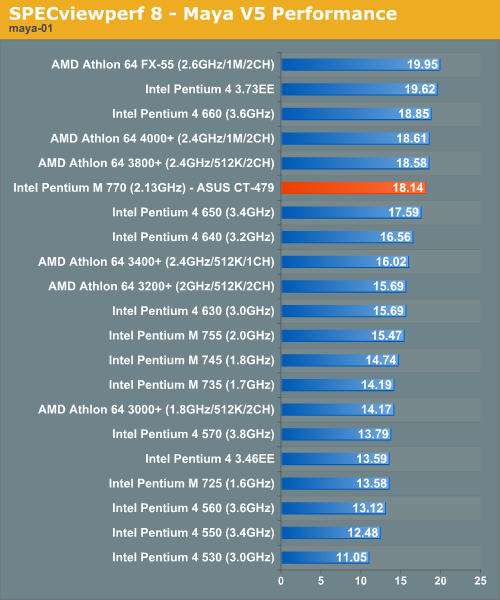
Pro/ENGINEER (proe-03)
"The proe-03 viewset was created from traces of the graphics workload generated by the Pro/ENGINEER 2001TM application from PTC.
Two models and three rendering modes are measured during the test. PTC contributed the models to SPEC for use in measurement of the Pro/ENGINEER application. The first of the models, the PTC World Car, represents a large-model workload composed of 3.9 to 5.9 million vertices. This model is measured in shaded, hidden-line removal, and wireframe modes. The wireframe workloads are measured both in normal and antialiased mode. The second model is a copier. It is a medium-sized model made up of 485,000 to 1.6 million vertices. Shaded and hidden-line-removal modes were measured for this model.
This viewset includes state changes as made by the application throughout the rendering of the model, including matrix, material, light and line-stipple changes. The PTC World Car shaded frames include more than 100MB of state and vertex information per frame. All state changes are derived from a trace of the running application. The state changes put considerably more stress on graphics subsystems than the simple geometry dumps found in older viewsets.
Mirroring the application, draw arrays are used for the shaded tests and immediate mode is used for the wireframe. The gradient background used by the Pro/E application is also included to better model the application workload."
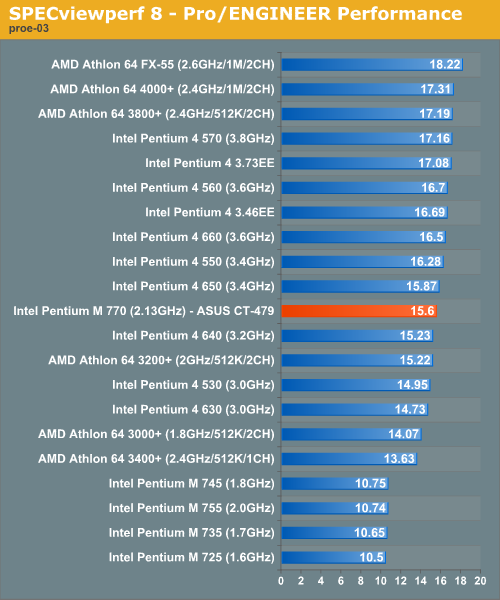
SolidWorks Viewset (sw-01)
"The sw-01 viewset was created from traces of the graphics workload generated by the Solidworks 2004 application from Dassault Systemes.
The model and workloads used were contributed by Solidworks as part of the SPECapc for SolidWorks 2004 benchmark.
State changes as made by the application are included throughout the rendering of the model, including matrix, material, light and line-stipple changes. All state changes are derived from a trace of the running application. The state changes put considerably more stress on graphics subsystems than the simple geometry dumps found in older viewsets.
Mirroring the application, draw arrays are used for some tests and immediate mode used for others."
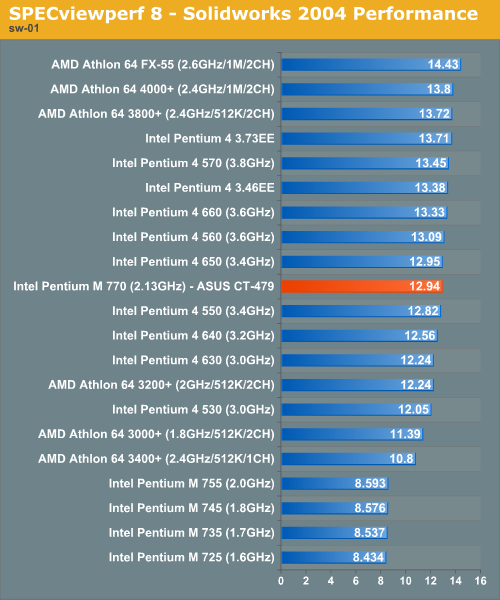
Unigraphics (ugs-04)
"The ugs-04 viewset was created from traces of the graphics workload generated by Unigraphics V17.
The engine model used was taken from the SPECapc for Unigraphics V17 application benchmark. Three rendering modes are measured: shaded, shaded with transparency, and wireframe. The wireframe workloads are measured both in normal and anti-alised mode. All tests are repeated twice, rotating once in the center of the screen, and then moving about the frame to measure clipping performance.
The viewset is based on a trace of the running application and includes all the state changes found during normal Unigraphics operation. As with the application, OpenGL display lists are used to transfer data to the graphics subsystem. Thousands of display lists of varying sizes go into generating each frame of the model.
To increase model size and complexity, SPECviewperf 8.0 replicates the model two times more than the previous ugs-03 test."
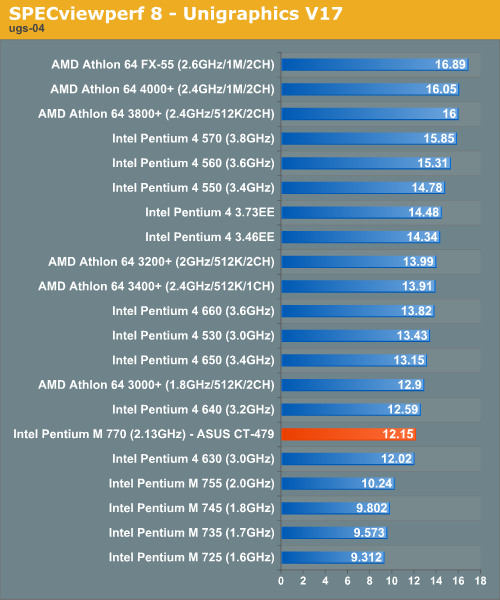










48 Comments
View All Comments
ElFenix - Sunday, March 27, 2005 - link
i'm confused, were all the benches done at 5:4 memory ratio? how is the performance at 1:1? if the added bandwidth from running 5:4 can't be used, isn't it better to run synchronus?joe360 - Saturday, March 26, 2005 - link
I have a socket-478 P4 2.8 Presscott in a laptop, is there a way I can get the Dotan in there instead?Hardtarget - Friday, March 25, 2005 - link
Wow thanks for the update Anand. I just read both of these articles and was extremely impressed with them.Real good work, I can't wait for the Yonah just to see what happens!
drewski - Friday, March 25, 2005 - link
i agree w/ posts 9, 18, & 28 regarding the changing of multiple variables making some of the comparisons between architecture's a bit of a guess.thanks for your post, Anand. it helps clarify things, though having the benches would help. maybe you can cut and paste it into the article! ;-)
still, i think this was less of an oversight than that terrible article on the OCZ Vx memory by Wesley. has that ever been corrected?
Anand Lal Shimpi - Friday, March 25, 2005 - link
For those wondering about the 865 vs 855 comparison, one thing I tried to stress in the article (especially during the benchmark comments) is that in many cases the performance improvement was barely anything, thus meaning that the magic solution to the Pentium M's desktop viability was far from just add more memory bandwidth. The reason that point is important is because after the first article, many assumed that more memory bandwidth and a faster FSB would make the Pentium M infinitely more competitive. But look at media encoding and the majority of the MCC tests and those two improvements didn't change things all that much.The Pentium M 770 has a 6.65% increase in core clock speed over the Pentium M 755, in any benchmark where the 770 offers a greater than 6.65% increase in performance you know that performance improvement is due to more than just the clock speed, mainly the faster FSB and the correspondingly higher memory bandwidth. Since the 855GME is already memory bandwidth limited with a 400MHz FSB, increasing the bus frequency to 533MHz won't do anything for performance on that chipset, so that's why you can attribute the performance gains that do exist to the 865 platform as a whole. Also keep in mind that most applications rarely scale at a 1:1 ratio with CPU clock speed; even some of the more CPU limited applications will scale at a 50% rate with clock speed - so really what you're looking for are any performance improvements greater than about 3%, those are due to the 865 platform.
There are a few areas where the added memory bandwidth does make a huge difference - mostly in the workstation level SPEC tests.
So although we didn't run direct comparison numbers between the 855GME and the 865, there is enough information in this article to (as many of you have already concluded) find out that for the most part, the added memory bandwidth does very little (on the order of a few percent). The real benefit of the ASUS solution is that you get a much more mature motherboard, more stable, and a lot cheaper. I apologize if I didn't properly stress this information throughout the article and in the conclusion.
Take care,
Anand
PrinceGaz - Friday, March 25, 2005 - link
#31- the P-M 770 has a 533MHz FSB. That's how fast data moves to and from the northbridge memory-controller. The CPU doesn't care about whether the chipset memory-controller is single or dual-channel. Using dual-channel DDR333 provides 667MHz of memory bandwidth for the northbridge, of which the P-M 770 will utilise a maximum of 533MHz (when not overclocked), so it is taking advantage of dual-channel.Unfortunately, as others have pointed out, the article was very poor because there was no comparison of the same P-M on the i855 (single channel) and i865 with adapter (dual channel) chipsets. The purpose of the article was to see what effect the adapter and i865 had on performance. Of course the P-M 770 on the i865 was faster than the P-M 755 on the i855, because the P-M 770 has a higher core speed. What you did was like comparing a S754 3000+ (2GHz) and a S939 3500+ (2.2GHz), and concluding that S939 provides a good performance boost over S754 because it is dual-channel, whilst overlooking the clock-speed difference which has a much greater impact.
classy - Friday, March 25, 2005 - link
I don't even see this even as a viable solution. It is a real dog in many instances and the biggest problem is you have to overclock it. Now for many of us that is not a problem, until you factor in that your talking about a rather extreme overclock, even for an Intel Processor. If you can't reach these speeeds with a low priced one, only a fool would buy one. Especially now since I can go over to Zip and buy a retail AMD 64 4000+ for $550 dollars. And don't forget AMD 64 chips overclock fairly well too. If this was 2 years ago it would be viable or even if was say the priced like an XP or 64 3000+ chip you might consider it. But given the necessiity that it has to be overclocked to get good performance, high price, and extremely limited platform support I see no reason whatsoever to buy a Pentium M. And I am running an Intel setup as I type this. They have just fallen behind and it doesn't look like they are going to catch up any time soon either.fitten - Friday, March 25, 2005 - link
Something to remember about the PentiumM, while the chipset it sits on may be dual channel memory, the PentiumM itself, is not. It's much like the Athlon XPs and the nForce2 chipset (CPU is single channel, chipset is dual channel). So, you really aren't comparing a "real" dual channel processor like the S939 and S940 Athlon64/Opterons. The PentiumM can only pull data in one channel width per read, regardless of the chipset it sits on. The S939/S940s can pull in two channel widths per read.That being said, there definitely seems to be some improvement in going to the hybrid dual channel boards.
Quanticles - Friday, March 25, 2005 - link
What about HL2 preformance when it's not overclocked?xsilver - Friday, March 25, 2005 - link
Where this cpu would really work is in a xpc system where extreme performance isnt really nessessary... but think of running the whole pc on only the 1 PSU fan